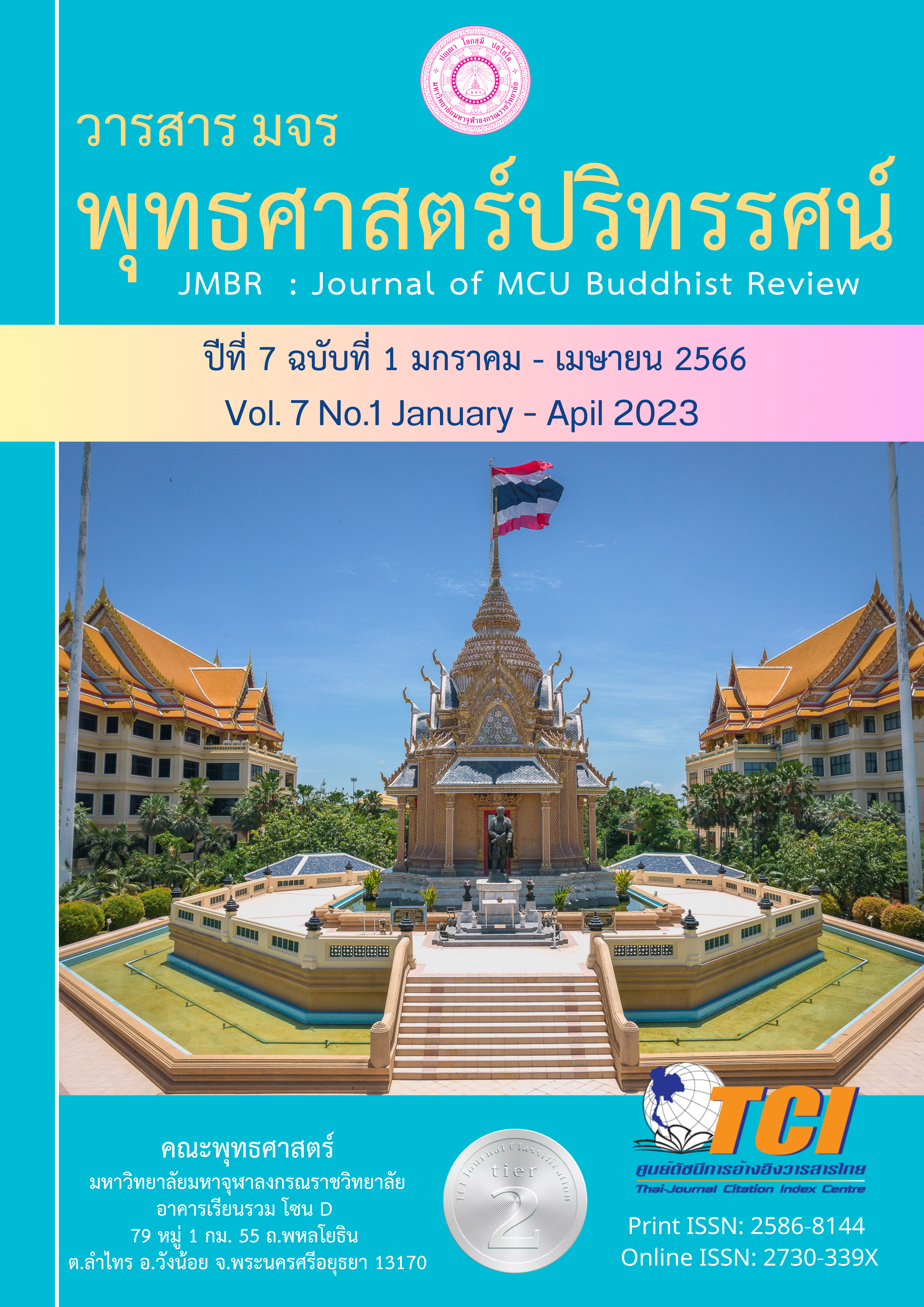คัมภีร์วิมลเกียรตินิทเทสสูตร: จากสุญญตาธรรมสู่ความว่างของพุทธทาสภิกขุ
Main Article Content
บทคัดย่อ
บทความนี้ มีวัตถุประสงค์เพื่อศึกษาสุญญตาธรรมในคัมภีร์วิมลเกียรตินิทเทสสูตรที่ส่งอิทธิพลต่อทัศนะเรื่องความว่างของพุทธทาสภิกขุ เพราะผู้เขียนสันนิษฐานว่า พุทธทาสภิกขุมีทัศนะเรื่องความว่างเหมือนกับหลักสุญญตาและตถตาในคัมภีร์วิมลเกียรตินิทเทสสูตรและน่าจะได้อิทธิพลของแนวความคิดดังกล่าวมาประยุกต์กับการอธิบายพุทธธรรมฝ่ายพุทธศาสนาเถรวาท ผลของการศึกษา พบว่า คำสอนเรื่องหลักสุญญตาและตถตา ปรากฎอยู่ในคัมภีร์วิมลเกียรตินิทเทสสูตรและคำสอนเรื่องความว่างของพุทธทาสภิกขุ กล่าวได้ว่า พุทธทาสภิกขุ ได้นำเอาหลักสุญญตาและตถตาในคัมภีร์วิมลเกียรตินิทเทสสูตรมาประยุกต์ในการอธิบายสอนธรรมทางฝ่ายพุทธศาสนาเถรวาทอย่างกลมกลืน โดยนิยามคำว่า สุญญตา คือความว่าง และตถตา คือความเป็นเช่นนั้นเอง อย่างไรก็ดี แม้ว่าคำสอนของทั้งสองฝ่ายจะอยู่คนละฝ่ายนิกาย แต่ยังคงเป้าหมายเชิงอุดมคติเพื่อการหลุดพ้นจากความทุกข์ทั้งมวลเช่นเดียวกัน
Article Details

อนุญาตภายใต้เงื่อนไข Creative Commons Attribution-NonCommercial-NoDerivatives 4.0 International License.
- บทความที่ได้รับการตีพิมพ์เป็นลิขสิทธิ์ของวารสาร มจร พุทธศาสตร์ปริทรรศน์
- ข้อความใดๆ ที่ปรากฎในบทความที่ได้รับการตีพิมพ์ในวารสาร ถือเป็นความรับผิดชอบของผู้เขียนบทความ และข้อคิดเห็นนั้นไม่ถือว่าเป็นทัศนะและความรับผิดชอบของกองบรรณาธิการวารสาร มจร พุทธศาสตร์ปริทรรศน์
เอกสารอ้างอิง
ไดเซ็ต ไตตาโร่ ซูซูกิ. (2560). คัมภีร์มหายาน ลังกาวตารสูตร. แปลโดย พระราชปริยัติกวี. พิมพ์ครั้งที่ 2. กรุงเทพฯ: มหาจุฬาลงกรณราชวิทยาลัย.
พระมหาพุทธรักษ์ ปราบนอก. (2547). การศึกษาวิเคราะห์คัมภีร์มหายานสูตราลังการ. วิทยานิพนธ์ศิลปะ ศาสตรดุษฎีบัณฑิต บัณฑิตวิทยาลัย: มหาวิทยาลัยศิลปากร.
พุทธทาสภิกขุ. (2546). สุญญตาปริทรรศน์ เล่ม 1. พิมพ์ครั้งที่ 2. ธรรมทานมูลนิธิ.
พุทธทาสภิกขุ. (2548). คุณบิดามารดา สุดพรรณนามหาศาล รมปาฐกถา ๓ นักปราชญ์ร่วมสมัย (ตถาตาหน้าเชิงตะกอน ของพระธรรมโกศาจารย์ (พุทธทาสภิกขุ). กรุงเทพฯ: มหาวิทยาลัยมหาจุฬาลงกรณราชวิทยาลัย.
พุทธทาสภิกขุ (2548). ตัวกู ของกู ฉบับสมบูรณ์. พิมพ์ครั้งที่ 2. กรุงเทพฯ: สุขภาพใจ (บริษัท ตถาตา พับลิเคชั่น จำกัด).
มหามกุฏราชวิทยาลัย. (2514). พระไตรปิฎกฉบับหลวง ภาษาไทย. กรุงเทพฯ: มหามกุฏราชวิทยาลัย.
มหามกุฏราชวิทยาลัย (2552). พระไตรปิฎกฉบับหลวง ภาษาบาลี. กรุงเทพฯ: มหามกุฏราชวิทยาลัย.
สราวุธ โพธิ์ศรีขาม. (2562). แนวคิดเรื่อง ตัวกู ของกู ในทัศนะของพุทธทาสภิกขุ. วิทยานิพนธ์ปริญญามหาบัณฑิต ภาควิชาประวัติศาสตร์ ปรัชญา และวรรณคดีอังกฤษ: มหาวิทยาลัยธรรมศาสตร์.
เสถียร โพธินันทะ. (2506). วิมลเกียรตินิทเทสสูตร. กรุงเทพฯ: มหามกุฏราชวิทยาลัย.
เสถียร โพธินันทะ. (2516). วัชรปรัชญาปารมิตาสูตร ชุมนุมพระสูตรมหายาน. กรุงเทพฯ: โพธิ์สามต้น.
เสถียร พันธรังสี. (2543). พุทธศาสนามหายาน. พิมพ์ครั้งที่ 4. กรุงเทพฯ: หจก. เอมี่ เทรดดิ้ง.
สุมาลี มหณรงค์ชัย. (2546). พุทธศาสนามหายาน. กรุงเทพฯ: ศยาม.
Pine, Red. (2004). The Heart Sutra: The Womb of the Buddhas (2004). Shoemaker 7 Hoard.
Davids, T. W. R. and Stede, W. (1952). The Pali Text Society's Pali-English dictionary Edited. by T. W. Rhys Davids and William Stede. Published by The Pali Text Society. LONDON: Printed in Great Britain by Biling and Sons Ltd., Guildford and Esher.
Robert,A.F.T. (1976). VIMALAKIRTI NIRDESA SUTRA. Translated by Robert A. F. Thurman. copyright 1976. The Pennsylvania State University.


